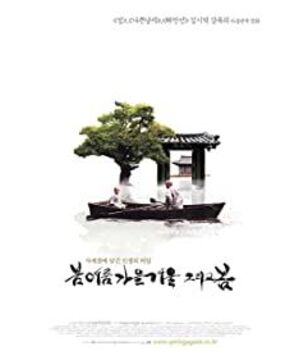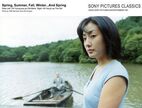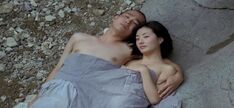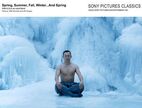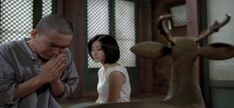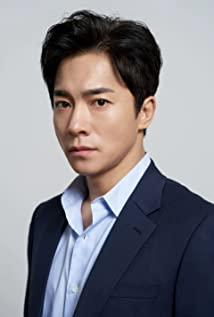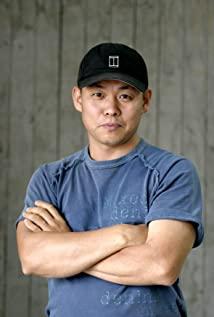I finally watched the movie "Spring, Summer, Autumn, Winter and Spring" this week. I heard someone introduce it a few years ago, and they kept saying that I would find time to watch it completely, but it was delayed until this week. However, after watching it, I fell into deep contemplation, what exactly is this movie about, and what does it want to tell us? Is it human nature and desire, causality and reincarnation, or epiphany and detachment?
When he was young, he was ignorant and harmed living beings; when he was young, his lust became dark, and he lived with the young lady; in middle age, he murdered for love and was imprisoned; At the same time, he took a little monk to practice. There are many Buddhist elements in the film, and many imagery is used in it. Dogs in Buddhism symbolize greed, hatred, violence and other evil thoughts and sins. The last Guanyin in Zhou Xingchi's "God of Cookery" also turned "Wu Mengda" into a dog. The dog in the film "Spring", I think, represents the little monk's evil thoughts, and the sins he committed, and also represents the source of the little monk's pain. Contrary to the dog, the chicken in Buddhism symbolizes the inherent nature of all living beings, and the same is true for the chicken in "Xia". release his own nature. The cat in "autumn" symbolizes the little monk's ignorance of Buddhism. The old monk wrote the entire Heart Sutra on the ground with the cat's tail dipped in ink, expressing the little monk's ignorance of Buddhism and implying that the little monk really started from now on. Comprehension of Buddhism. There are also two images that appear frequently in the film, one is a snake and the other is a fish. Let’s talk about snakes first. Snakes are a symbol of anger and poison in Buddhism, and they are the representatives of all hatred, jealousy, anger, etc. When the little monk went to pick up the little sister, he saw two snakes mating on the road, which foreshadowed the love between the little monk and the little sister, and also foreshadowed the future. If greed is not satisfied, it will turn into hatred. As the old monk said, maybe sex is a good medicine to cure greed, but once lust turns into possessiveness, you like something that others also like, which will lead to Uncontrollable anger will lead to death. The old monk was deeply touched by anger. When the young monk went to collect herbs, the old monk instructed him to be careful about snakes. It was the old monk himself who was really careful about snakes. I don't know what the old monk has experienced, what anger he has, and what pain he has endured, but from the young monk, you can see the old monk's mental journey. Later, when the old monk burned his body, a snake swam out, and there was a snake coiled on the mantle and mantle left by the old monk, indicating that the old monk still had the shadow of anger in his heart. Let's talk about fish, fish symbolizes freedom. The little monk always likes to catch fish, and the little sister also likes to watch fish. The little monk grabs the fish and puts it in the hand of the little sister, expressing that he gives his freedom to the little sister. After that, the two Wu Shan After some cloud and rain, the little monk followed the little sister and followed the freedom. There is also an interesting design in the movie. In the temple, there is a door between the "bedroom" and the "living room". This door has no function, and you must open the door, pass through this door, and close the door to enter and exit the bedroom. I think this door represents Buddhism, it represents the ancient Buddha with green lights, and it is clear of rules and precepts. The old monk blocked the door, and the young monk could only go out from the side and get into the bed of the young lady. Before, the young lady was not allowed to sit on the stone lion, once she crossed this Buddhist gate. She took the initiative to let the lady sit.
Fish and water are inseparable, and water symbolizes desire. In spring, the ice and snow melt and the water begins to flow, implying that a person is born with the growth and sprouting of desire. In summer, the water level overflows and overflows the temple gate, which refers to the continuous growth of desire. In the hot summer, the mood is impetuous, soaking in the water of desire is so cool and refreshing. In autumn, the wind is bleak and the water is cold, and desire is no longer so beautiful, and gradually tastes the pain caused by desire. In winter, water freezes into ice, and desire condenses. The little monk once rowed aimlessly on the boat, spinning non-stop, then jumped into the water and pulled the young lady into the water. The desires of the two are satisfied, but this is also the source of their suffering. The Buddha said that human suffering is caused by cause and effect. And the Buddha wants to cross people out of the sea of suffering, and help people overcome the suffering of the six realms of reincarnation. The boat in the film symbolizes the ferry boat. On the boat is a painting of Guanyin holding a lotus in his hand, and a person sitting on the flower. When the police took the little monk away, the boat could not move, but when the little monk looked back and said goodbye to the old monk, the boat could row normally again. I think it is saying that if you have a Buddha in your heart, you will naturally be able to cross. Originally, the little monk did not have a Buddha in his heart, but after this hardship, he already had a Buddha in his heart. This farewell is the farewell between the young monk and the old monk in this life, and it also alludes to the old monk's inheritance of the young monk's Dharma. There are no more monks who don’t understand Buddha, and cats who don’t understand Buddha are also released into nature.
The movie left the audience with a suspense at the end, who is that masked woman? Some people think it's the previous lady, and some people think it's just an ordinary woman. I think it's possible, but I'm more inclined to say that the previous lady. Judging from the body shape, the lying posture, and the exclaimed voice, it is very similar to the previous young lady. The details of touching the little monk's hand are also very strange. After the little monk fished out the woman's body, when he took off the veil and saw the woman's face, his body leaned back slightly. This should have been caused by surprise, indicating that he had seen this person. Afterwards, the Buddha statue that he took away when he went to the young lady was used for her water burial. All the details make me think that this woman is the previous lady. However, this is not important, the emphasis here is on the expression of causal reincarnation, suffering and redemption. Because of the sin of abandoning the child, she fell into the abyss of eternal redemption; because of her excessive desire, she was completely swallowed up by desire; because of her excessive possessiveness, she suffered a prison; because she dug a hole in the ice, If you cause someone else to fall into the water and die, you should also be punished. So began self-redemption, dragging big rocks up the mountain, just like the pain caused to small animals when they were young. And the mountain symbolizes the world, only to read the vicissitudes of the world, taste the pain of the world, look back and look back, my desire is so small, so worthless. And there will be bigger water outside the mountain, and there will be bigger mountains outside the water, layer by layer, ring by ring, endless. And he is only a pebble in this green mountain, a drop in the ocean. So what exactly is desire, what is the world? What is true and what is false? What is form and what is emptiness? The Buddha said: Form is not different from emptiness, and emptiness is not different from form; form is emptiness, and emptiness is form. The Buddha also said: All appearances are false. All are false, aren't they all true?
At the end of the film, the new generation of little monks gradually grew up and began to mutilate small animals. The next day, perhaps the new little monk will be stuffed with a big stone in his mouth... A new cycle begins. Spring, summer, autumn, winter and another spring, show the four stages of life with the four seasons, and also show the reincarnation of the world with the alternation of the four seasons. I think it also reflects several realms of life. When you are young, you see mountains as mountains and water as water; when you are young, you see mountains as mountains, but water as water; in middle age, you see mountains as mountains, and water as water. In old age, the desires of winter have condensed, and then the desires of spring will flow again. This is a Nirvana. Finally, the tortoise held by the new monk symbolizes Nirvana. I think Nirvana is precisely the idea of "Gui Liuzang", that is, the thought and behavior of the old monk who used the word "shu" to seal his eyes, ears, nose, and nose. In the face of all kinds of things in the world, you should not close your audio-visual isolation from the world. Even if you turn off audio-visual, you are still in the package of color and emptiness in this world, and there is still no reincarnation of excellence and emptiness. What should be done is to accept the various states of the world, to experience, to perceive, to see mountains as mountains, to see water as water, to see through the world, and see through all the falsehoods. To truly realize that the four elements are all empty, to achieve the supreme righteous enlightenment! Therefore, the old monk still had anger in his heart, and a snake still escaped.
The so-called "form is not different from emptiness, emptiness is not different from form; form is emptiness, and emptiness is form", I think it refers to the communication and mutual transformation of tangible and intangible matter. The old monk didn't interfere with their feelings from the beginning of the fight. I think it's also because of the idea that all causes and effects in Buddhism are planted by oneself. Just imagine if his wife hadn't cheated, would they live happily together until the end. If the little monk did not kill his wife, but accepted all this and went to find new happiness, would it be another ending. This is what Buddhism advocates and what most of us experience. We are also wandering between cause and effect, we also experience sin and redemption, and we also balance material and desire. Desires are the driving force for human progress and development, and desires are constrained by existing materials. Mastering the balance is the key to whether our lives are happy and beautiful. Maybe that's what this movie is trying to tell us.
View more about Spring, Summer, Fall, Winter... and Spring reviews


